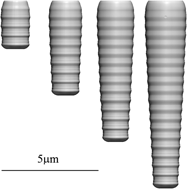Article contents
An approach to the three-dimensional simulations of the Bosch process
Published online by Cambridge University Press: 20 December 2011
Abstract

The Bosch process is a high-speed, deep reactive ion etching technology for silicon, which has both excellent flexibility and selectivity. For better understanding and control of the time evolution of the feature profile during the Bosch process, an accurate, predictive, and fast simulation tool would be useful. In this article, a simplified model for three-dimensional simulation of the Bosch process is proposed. Etching is modeled by an isotropic etching rate superposed by an anisotropic term. For the passivation cycle, a perfect conformal deposition is assumed corresponding to a constant deposition rate. Level set method was used for tracking the surface evolution. Since the etching and deposition rates are the model input parameters which are not computed, the computational time is significantly reduced. Calculation results presented here illustrate some typical applications of the Bosch process.
Keywords
- Type
- Articles
- Information
- Journal of Materials Research , Volume 27 , Issue 5: Focus Issue: Plasma and Ion-Beam Assisted Materials Processing , 14 March 2012 , pp. 793 - 798
- Copyright
- Copyright © Materials Research Society 2011
References
REFERENCES
- 6
- Cited by




